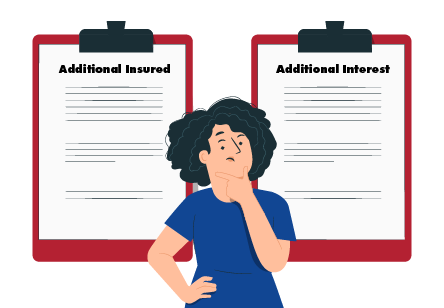Permissive use car insurance is not a standalone policy but a provision in many auto insurance policies. It covers unlisted drivers with the policyholder’s permission to use the insured vehicle. However, coverage is not automatic for all accidents, as policy terms and state regulations vary.
An auto insurance policy typically covers named drivers, most household members, and permissive users, but exceptions and exclusions may apply. Policyholders should check if their insurer offers permissive use coverage to avoid surprise liabilities and understand how it affects premiums and claims.
What is a Listed Driver on a Car Insurance Policy?
Before we discuss permissive drivers, let’s first understand who is covered by a car insurance policy. These are the people listed on your policy, also known as named drivers or named operators.
For example, your family’s policy may include the primary policyholder (also known as the named insured), their spouse, and any licensed children.
Licensed drivers in your household are usually listed as drivers since they have access to your vehicle. When a household member borrows your car, their coverage is not under permissive use.
It’s a good idea to review your policy details with your car insurance company to ensure that all household members are covered.
How Does Permissive Use Car Insurance Work?
Permissive use applies when a person has clear or assumed permission to drive your vehicle.
Expressed permission is direct, whether verbal or written. For example, if a coworker asks, “Can I use your car to pick up some supplies?” and you respond, “Sure, go ahead,” that’s expressed permission.
Implied permission doesn’t require direct approval and is often based on previous behavior, relationships, or the policyholder’s lack of objection.
Some examples of implied permission are listed below.
- Your neighbor who has borrowed your car multiple times before borrows it again to run a quick errand without asking.
- Helping with home renovations, your cousin grabs your truck keys to move them out of the way so they can unload construction materials.
- A visiting friend who has driven your car before with permission assumes they can use it again to go to the grocery store.
Permissive use can apply to almost anyone as long as they have your consent, whether explicit or implied. In that case, your auto insurance policy should still cover the person driving your vehicle, meaning they would be covered under your insurance if they had an accident.
However, not all car insurance companies offer permissive use coverage. While many larger insurers do, some only cover listed or “active” drivers on the policy.
Drivers excluded from your policy are never covered under permissive use, even if they take the car with your permission. Check your policy to see if you’re insured through a smaller or regional provider. Even if your policy has permissive use, there may be restrictions.
For example, some insurers limit coverage to occasional use, such as allowing someone to borrow your car no more than 12 times a year.
Permissive use car insurance is meant for infrequent or one-time situations where someone borrows your car and has an accident. Under permissive use, your auto policy will cover medical expenses and property damage if the permissive driver is at fault in the accident.
If someone regularly drives your vehicle, they should be listed as a named driver on your policy. Otherwise, if the car insurance company finds out an unlisted driver is using the vehicle regularly, they may deny coverage for any claims. Review your policy beforehand to avoid coverage gaps.
Does All of My Car Insurance Coverage Apply to the Permitted Driver?
Suppose someone not on your car insurance policy borrows your vehicle and gets into an accident. In that case, your insurance coverage usually applies to them, as long as they meet your insurer’s permitted driver requirements and are not excluded from your policy.
In most cases, all coverages in your policy, liability, collision, comprehensive, and medical payments coverage should apply.
For example, in Illinois, the state requires a minimum liability coverage of:
- $25,000 for property damage per accident,
- $25,000 for bodily injury per person, and
- $50,000 for bodily injury per accident.
If your policy has $25,000 in property damage liability coverage, then a permissive driver using your vehicle would be covered up to that policy limit. So, if your friend causes $20,000 in property damage while driving your car, your policy should pay for it.
However, not all insurers treat permissive use the same way. While more prominent car insurance companies extend full coverage to permissive drivers, smaller, non-standard insurance companies only transfer bodily injury and property damage liability, excluding comprehensive and collision coverage.
If you’re unsure what your policy covers, it’s best to review it or talk to your insurance agent before you let someone else drive your car.
When can a friend drive your car?
If someone else drives your car, your auto insurance policy usually covers authorized drivers under “permissive use,” meaning they are covered even if they’re not listed on your policy. Regular drivers, especially household members like a spouse, teenager, or roommate, should be added to your policy.
Some insurers and state regulations may also require listing any drivers in your household regardless of how often they use your vehicle. Not listing a frequent driver may result in denied coverage if they get into an accident.
Friends occasionally borrowing your car are generally provided primary coverage by your car insurance. Still, insurers may impose limitations, such as restricting excessive use (e.g., less than 12 times a year).
To ensure you have the proper coverage, check with your insurer to confirm if your policy has permissive use and doesn’t have exclusions that will affect a friend’s ability to drive your car with protection.
Which Family Members are Covered by Your Car Insurance Policy?
In most cases, spouses of the named insured are covered under liability policies regardless of what vehicle they are driving, even if it is not listed on the policy.
Other household members who are related to the named insured and live in the household are usually covered. This can be blood, marriage, or adoption-related.
But if you want to add a roommate or foster child to your auto insurance coverage. You must check with your insurance company to see if they qualify as a household member under your policy. Suppose they don’t qualify as a household member. In that case, you must list them specifically as a covered driver to ensure they are covered.
When Should Someone Be Added as a Named Driver, Temporary Driver, or a Permitted Driver?
The major factor in deciding whether someone should be a named driver on your auto insurance policy or can remain a permissive driver is the frequency of use.
- Permissive Use: If someone borrows your car 12 times or less per year, they are generally considered a permissive user. But remember that they are counted separately each time they get in and out of the car. If someone occasionally borrows your vehicle, they don’t need to be listed as a named driver.
- Named Driver: If someone regularly uses your car, like a neighbor who takes your kids to soccer practice every week. They should be added to your policy as a named driver. This applies if they use your car more often than permissive use allows.
- Temporary Use: If a driver will be using your car for an extended period, like a multi-week road trip, consider adding them temporarily to your policy. This will increase your insurance premiums, but you can remove them later.
For exact coverage limits and requirements, call your insurance company and ask before you let somebody else drive your car. This will ensure you have the right coverage in place and avoid out-of-pocket expenses if an accident occurs.
Exceptions to Permissive Use Coverage
Permissive use allows a vehicle owner to insure another driver who borrows their car. But there are several key exceptions:
- Unauthorized Drivers - Permissive use doesn’t apply if the driver doesn’t have the owner’s permission or a valid driver’s license.
- Business Use Exclusion - If the borrowed car is used for business purposes like making deliveries or driving for a rideshare service, the car insurance may not cover any damages unless a business use endorsement is added to the policy. So, even if the owner doesn’t use the car for business, they could be left without coverage if the borrower does.
- Criminal Activity - If the car is used for a crime, the car insurance won’t provide coverage.
- Intentional Acts - Any damages caused by the borrower will not be covered under permissive use.
- Excluded Drivers - There is no coverage if the owner has excluded a driver in writing.
- Unlicensed Drivers - Lending the car to an unlicensed driver may result in full coverage denial if an accident happens. Car insurance companies may also deny coverage if the driver is inexperienced. They say they assess risk and set premiums based on the listed policyholder’s driving record.
These exceptions remind us to review our auto insurance policy before lending a car. Unintended violations can result in considerable financial risk.
Get a Free Car Insurance Quote Online from Insurance Navy!
Affordable Car Insurance is only a click away or a phone call away. Get a quote online or call an insurance agent at 888-949-6289 for more information.
Frequently Asked Questions
Do all auto insurance policies include permissive use of car insurance?
Most policies include permissive use coverage, but some require all drivers to be listed on the policy to be fully covered. Check your policy documents to see if your policy includes permissive use. If you are unsure if your coverage extends to other drivers, contact your insurer before letting someone else drive your vehicle.
What happens if my girlfriend is driving my car and gets in an accident?
Suppose your girlfriend or a friend is driving your car and has an accident. In that case, the general rule is that the at-fault driver is responsible for damages. But if the other party is at fault, their car insurance will typically cover the costs.
Can my son drive my car if he doesn’t live with me?
Your son can drive your car with your permission even if he doesn’t live with you. This is permissive use, which means that when a non-household member is allowed to drive your vehicle, your auto insurance coverage generally extends to them.
What happens if I don’t add my teenager to my car insurance?
Suppose you don’t add your teenage driver to your policy. In that case, you may face coverage denial, legal penalties, or policy cancellation. Teen drivers have higher car insurance rates due to limited driving experience and increased risk factors.
What happens if a driver is not listed on my insurance?
Neglecting to list a driver on your auto policy can cause issues in determining liability. It may also be a breach of coverage. Your insurer may impose penalties or cancel your policy. If an unlisted driver is at-fault in an accident, your insurer may deny the claim or only provide limited coverage.




